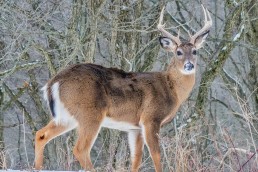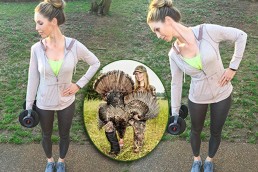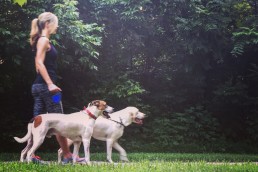On Counting Whitetails and Beers
SHARE THIS POST
So here’s a tricky question: What does drinking beer and white-tailed deer have in common? You should think of this question when you go out for a few cold ones with buddies and think you’ve enough. Some will think that you should stay for one or two more, but you know your sweetie might think that you’ve already had one too many. When it comes to white-tailed deer, if you ask three people whether the deer population is just right, if we need a few more or already have too many, you may get three different answers.
Over the years, I’ve had the chance to ride with fisheries personnel and learn about the new programs they are working on when it comes to walleye reproduction and stocking in southwest Minnesota. About a year ago I got a call from Bill Schuna, the DNR area wildlife manager, whose office is in Slayton. He asked if I wanted to volunteer one night to help him estimate deer numbers. I said yes.
We met at the Grain Exchange in Slayton for supper and spent 90 minutes discussing what Bill had done in the past, where he worked and what areas of wildlife management he enjoyed the most. It was very interesting and Bill is a top-shelf guy whose heart and brains are in the right place so southwest Minnesota’s wildlife resources are the best that they can be.
When it comes to estimating deer numbers, there has never really been much of an exact science. Harvest numbers were always the mainstay of this information-gathering effort. Hunters are required to register their kills so harvest numbers can be recorded. Hunters used to have to take the actual animal to a registration station, but you can now do it online and this has helped improve the reporting consistency.
Another method to estimate deer numbers in the past was deer depredation reports. If the numbers of farmers and ranchers who had trouble with deer eating off of their livestock forage piles were up, this was an indication that deer numbers were also higher, and vice versa. Area wildlife managers and their staff also made their own rounds in areas to add their own sense of what was happening on the landscape. The managers would all get together and submit their findings and then the group would decide how many doe permits were needed in each hunting permit area to keep populations in line with what the habitat could support, and what social constraints could or would allow. If you hit a deer with your car most people think there are deer all over and that the population is out of control. If you hunted an entire season and saw almost no deer you would call the department and say all the deer had been killed off and populations needed to be protected so they could rebound.
When populations are high they issue more doe permits. If she is killed, obviously she will not raise fawns the following year. Kill more does and numbers will decline. Reduce the number of does killed and the deer herd will expand. Many people with a buck tag will not shoot one in a given season, but almost every person with a doe permit is successful in killing a female deer.
The DNR is undertaking a new research project in five counties in southwest Minnesota. They used a student’s thesis to set up a possible new method to estimate deer numbers. It involves computer data entered and the model uses this data to come up with a few different scenarios to estimate deer numbers. The local DNR personnel are at the end of Year Two of the three-year collection. When the third year is done, the outcomes of this research will be distributed and peer-reviewed by other researchers. If they find the results to be verified by their science and experience, we might get a new way of determining the number of deer in a given area.
This data can be collected by driving the same routes at the same times of the days taken from the aforementioned study. In this case, it was after sunset to about midnight for us. We drove a predetermined route and surveyed deer with the use of a high-beam spotlight. We would look for deer on both sides of the road at 20 mph. When we saw the reflection of their eyes we’d just stop and count them. We would “distance” them from the road with a rangefinder and report their exact location. We would then drive a few miles to get to the next survey spot. This went on from 8 p.m. until 12:30 a.m. and got home after my normal bedtime.
Each route is driven several times a year and runs from front to back and then from the back to front in order to get the most even report of deer counts. Times of the sightings, wind speeds and outdoor temperature is also added as data to the model.
Are you enjoying this post?
You can be among the first to get the latest info on where to go, what to use and how to use it!
We are a few years out as to when the outcome of this effort will be completed, and, if it will even work is still unknown. I like the fact they we are trying harder to get accurate numbers of deer on the landscape. Deer need habitat and winter feed, and if deer numbers are to possibility rise as a result of this effort, hunters and others will need to understand that food plots on public land will need to be increased so they don’t start making trouble for the cattle guys, farmers and others.
One of the interesting things about my participation in this research is just how far away you can see a deer at night. I ranged one 485 yards and that deer stuck out like a sore thumb. The deer’s eyes glowed like a laser beam and it just stood there like it was hypnotized. Minutes would pass and the deer would still be right there. I see why poaching and “shining” deer is not allowed—I could have shot 50 deer in one night alone. And, we saw at least 100 deer in only four hours.
Many of the deer were bedded down within 50 feet of the road. They must lie there and watch the traffic go by, so well camouflaged that no driver even knows they are there.
I must have seen at least 200 raccoons in this trip. With so many coons, I can’t believe that any ground-nesting bird could ever bring off a clutch. Raccoons are nest predators, and if it were up to me there would be no closed season on them. My understanding is this used to be the case, but the trapping interests got them protected with a posted season. I would change that back if I were in charge.
It was just a great night learning about how deer are managed and what can be done to control the herd numbers.
As for gauging deer numbers, I’ll also go by how many I see while pheasant hunting—and I hunt for these birds a lot. My dogs don’t chase deer, but do spook them up when we pass through an area, making getting their numbers count harder. But when you can walk in managed ideal habitat and not see many deer, I think it’s safe to say the deer numbers are low. Sure, in the winter when they bunch up there may seem to be many, but I think the last posted population number for deer in Unit 237 (Nobles and Murray counties in Minnesota) was estimated to be 2.25 deer per square mile. Back in the heyday of deer hunting here it was estimated to be at 7.5 deer per square mile.
And as for the question of having one more drink with friends, I’m definitely the buddy who thinks I should have another beer. Should we have one more beer? Have we had just the right number? Or, have we had one too many? But when it comes to deer numbers, with or without research, there may never be the perfect answer to satisfy all.
MWO
SHARE THIS POST
Did you enjoy this post?
You can be among the first to get the latest info on where to go, what to use and how to use it!
Scott Rall
Scott Rall is an avid hunter, dog trainer, passionate land manager, and President of Nobles County Pheasants Forever chapter. He’s also the longtime outdoor columnist for the Worthington Daily Globe. We welcome his voice to MidWest Outdoors.


